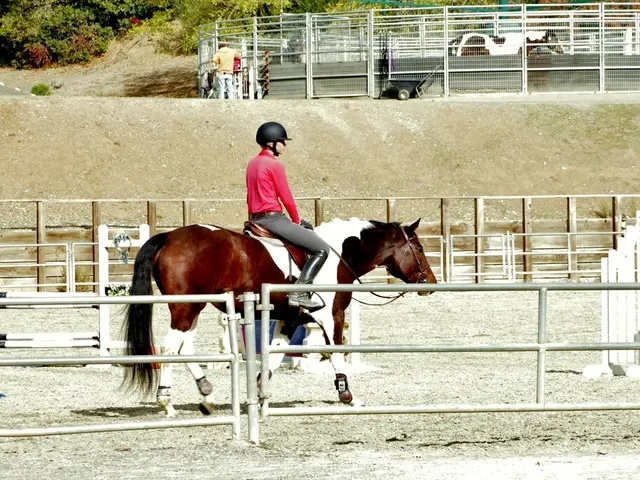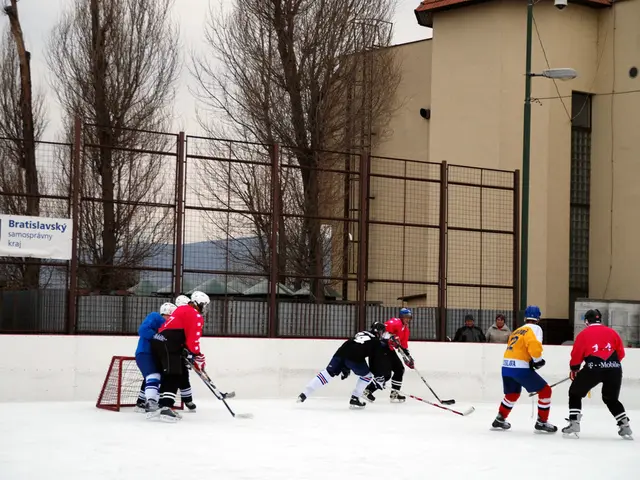The Final Stand: Berlin's Deserters and Frenchmen - A Grim Defiance of Hitler's Stronghold
- Written by Gernot Kramper
- Estimated Reading Time: 6 minutes
Defenders of Hitler's Last Redoubt: Deserters and French Citizens Stand Guard - Deserters and French Citizens: Guarding Hitler's Final Stronghold
After the Soviet troops besieged Berlin, SS officer Wilhelm Mohnke was tasked with defending the government quarter. Mohnke, a die-hard nationalist, was determined to hold every inch until the last man stood. Despite the grandiose buildings, wide avenues, and numerous waterways aiding the defenders, the situation was dire - as Mohnke himself acknowledged. In this "final battle," the sole objective was to delay the inevitable by a few days. From a military perspective, the endeavor was senseless; in fact, Brigadeführer Mohnke merely bought Hitler time to prepare his suicide. Mohnke hailed from the 1st SS Panzer Division "Leibstandarte SS Adolf Hitler," a notorious elite formation of the Third Reich. However, the division was mostly absent in Berlin. Mohnke found himself there due to a stroke of luck - he had just left the hospital after a severe wound.
An Unconventional Group of Combatants
Mohnke's soldiers were a heterogeneous group. Mohnke's combat group consisted of fragments of the Leibstandarte, regular units, and the Volkssturm. The Volkssturm, the last resort, was usually poorly trained and woefully unprepared for the unique challenges of an urban combat in the densely populated inner city of Berlin. Other contingents also joined their ranks. At the bottom were men from a punishment battalion, far from eager to die as heroes for the "Führer." On the other hand, select elite fighters were present for the final battle, including Georg Diers, who battled with two colossal "King Tiger" tanks - number 314 and 100. These tanks, presumably part of the heavy SS Panzer Battalion 503, operated in the Schönhauser Allee and in the Tiergarten Ost. The most reliable support came from foreign volunteers who had joined the foreign SS units during the war – most of them voluntarily. These foreign fighters knew that the collapse of the Third Reich meant their own demise. They feared being shot upon capture and had no choice but to stay with Hitler until the bitter end. Among them was the SS Division "Nordland," which was stationed in the Tiergarten. However, the Frenchmen played a unique role. The members of the SS Division "Charlemagne" defended the Reichstag building, where the German parliament currently resides.
The Reichstag held tremendous symbolic significance in the Battle of Berlin. For Stalin and the Soviets, the parliamentary building embodied the heart of the Third Reich. Architecturally, such an assessment is warranted, but in Hitler's regime, the parliament played at most a minor role and became insignificant with the onset of the war. Hitler's hideout, though unknown to the Red Army, lay in the bunker beneath the Reich Chancellery, and no special efforts were made to capture this location from which Hitler governed his faltering empire. On the contrary, it was only after the surrender that the Soviet troops discovered Hitler's last refuge. The insignificant Reichstag, however, was of the utmost priority. The capture of the Moltke Bridge, which provided access to the government district, was crucial for Soviet advance. On April 28, 1945, around 5,000 defenders, including parts of the Mohnke combat group, fought valiantly, partially destroying the bridge at great cost. Soviet soldiers eventually overcame the obstruction, but only after sustaining heavy casualties. A Soviet report states, "The Germans defended the bridge with everything they had – machine guns, anti-tank weapons, even explosive charges. Our soldiers had to clear the rubble under fire." With fresh troops, the Germans were pushed back until the building was ultimately stormed. On April 30, 1945, soldiers of the 150th Rifle Division hoisted a red flag over the Reichstag, but fighting in the cellars and upper floors continued until May 1. For the Soviets, the building represented a powerful symbol of victory. War correspondent Konstantin Simonov wrote, "The Reichstag is almost a place of pilgrimage."
The Meaningless Battle
The struggle was militarily senseless but held great symbolic value for the defenders. For the Soviets, it was the same. After storming the Seelow Heights at the Oder and encircling Berlin, the Soviets could have driven the German troops out of the sprawling suburbs and isolated them in the city center. They could have weakened the Germans with their overwhelming superiority in artillery and bombers, and in a short amount of time, the Wehrmacht would have run out of supplies, consequently resulting in the Red Army's victory. For the civilian Berliners, the situation was already catastrophic: no electricity, barely any water, destroyed streets. This approach would have taken several weeks, but Stalin did not want to wait that long. The USSR was racing against the Western Allies, who met minimal resistance after encircling the Wehrmacht in the Ruhr pocket. Stalin put pressure on his army leaders, who, in turn, competed with each other, and at the next level, individual units vied for supremacy. The resulting atmosphere led to the fierce fighting in the Berlin city center. In essence, Stalin's pressure granted the fanatical defenders the chaotic, final battle they desired.
A 16-year-old named Günter Debski was conscripted in 1945. His parents hid him, but he was discovered and sentenced to death. Rather than being executed, he was sent to the infamous penal battalion 999. After the brutal battle for the Seelower Heights, he ended up in Berlin with other deserters, marked with the badge of the penal battalion. As a working-class citizen, Debski harbored resentment towards Nazism. Later, Khrushchev honored him for aiding two captured Red Army soldiers escape during the final weeks of the war. Nevertheless, this teenager found himself defending Hitler's last bastion. In an interview, Debski stated, "We were ordered to defend the southern side of the Reichstag. [...] An SS unit was already inside the Reichstag." The madness of the last days was indescribable. On April 28, 1945, Debski was tasked with approaching the Soviets as a парламентарий – not to persuade his unit to surrender, but to demand that the Red Army lay down their arms. "That's impossible, I said, Herr Leutnant. They'll shoot us. Everything's shooting here. We can't go over there with a white flag and negotiate that they surrender." A heavy artillery shell struck the officer, effectively ending the mission. Debski survived the war and imprisonment, where he witnessed horrors such as cannibalism.
Growing Despair
The SS unit within the Reichstag mentioned by Debski consisted of Frenchmen. It was hardly a division. Only about 300 to 350 Frenchmen reached Berlin in total. On May 2, 1945, at the surrender of Berlin, only about 30 Frenchmen remained alive. In the last hours, Mohnke organized escape attempts to the north to avoid being captured by Soviet troops. Most of these attempts failed in the destroyed streets of Berlin. Mohnke later explained, "We knew it was pointless, but we didn't want to fall into Soviet captivity." The French, who were strictly anti-communist, differed significantly from the German origins of the Waffen-SS. In the Wilhelmstraße, where the Reich Security Main Office and other ministries were defended, they fought bitter house-to-house battles. The "Charlemagne" volunteers relied on U-Bahn shafts and cellars to attack Soviet tanks from ambush. A Soviet report states, "The French fought like madmen, jumping out of the rubble and throwing grenades before disappearing back into the darkness." Among them was Paul Briffaut, a Catholic priest who accompanied the fighters. The French, often aristocratic or royalist anti-communists, saw the fall of the Third Reich as their own demise. One of them described the mood, "We knew it was over, but we fought for our convictions, not for Germany."
Christian de La Mazière was an aristocrat, more of a royalist than a Nazi. He joined the SS after the fall of Paris in 1944, by which time the war was clearly lost. He was the last survivor of the Charlemagne unit, captured in Pomerania, and was not present in Berlin. In an interview, the intellectual described the mood of the fighters during the final days of the war, "The city was burning. Walls, buildings, everything was collapsing. The smoke of the fires, the dust of the crumbling buildings – sometimes we couldn’t breathe. We didn’t know where we were. We couldn’t tell night from day. In the breaks, we heard the screams of women. It was horrifying. The sky was falling on us. There was nothing. We jumped into the void. Hopeless, a total vacuum. A great grinding. We were nothing. Life had no more meaning, we didn’t care about our own lives." Due to their firm anti-communist beliefs, the French refused to surrender and died fighting against the Soviets.
- The Frenchmen in the Charlemagne unit, despite being a small group, fought fiercely in the Reichstag, embodying their strong anti-communist convictions.
- Mohnke, the commander of the diverse combat group, organized escape attempts to the north as the final battle neared its end, motivated by the desire to avoid capture by the Soviet troops.
- Gernot Kramper's article, titled "The Final Stand: Berlin's Deserters and Frenchmen - A Grim Defiance of Hitler's Stronghold," discusses various aspects of the final battle, providing insights into politics, general news, and even sports-analysis.
- The struggle for the Reichstag was symbolically significant for both sides, as the building represented the heart of the Third Reich for the Soviets and held insignificant political power for Hitler's regime.
- Georg Diers, an elite fighter, operated two colossal "King Tiger" tanks in the final battle, contributing to the overall chaos and senseless military endeavor.








